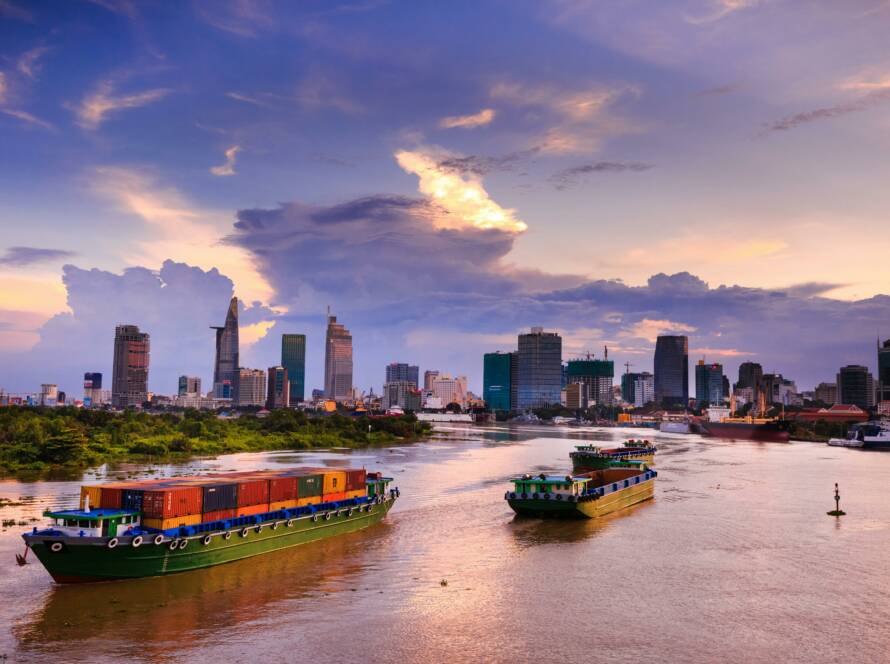Across the world, millions of tonnes of grain are harvested each year — from Australia and the United States, to Argentina, Ukraine, Canada and beyond. But growing the grain is only half the challenge. The real challenge comes after the grain has been harvested — moving it from rural farms to buyers around the world.
And it is not as easy as simply putting it on a ship and sailing away. Moving grain is an intricately coordinated process and relies on a connected system of inland transport, port infrastructure and the documentation workflows needed to meet international trade compliance and biosecurity.
In this article, we share insights based on our hands-on experience at Sharp Blue Pty Ltd, highlighting the critical role freight forwarders play in bridging the Grain Belt to global markets. As a key connector in this complex network, we ensure that grain moves efficiently, meets all regulatory requirements, and reaches international buyers profitably. Our expertise and commitment make us an indispensable partner for producers navigating the challenges of global grain trade.
What is the Grain Belt?
“Grain Belt” refers to the large high-yield agricultural areas around the world where the climate, soil, and agricultural infrastructure are ideal for growing staple grains like wheat, corn, barley, and soybeans at a commercial scale.
Major grain belts from around the world includes:
- North America: U.S. Corn Belt (Iowa, Illinois, Nebraska) and Canada’s Prairie Provinces.
- Australia: Western Australia, Victoria, and New South Wales.
- South America: Argentina and Brazil’s grain-producing Pampas.
- Asia: China and India for rice and wheat.
- Eastern Europe: Ukraine and Russia, key players in the global wheat market.
While these regions are highly productive, they are far removed from the major consuming regions of the world. The movement of grain from the inland farms to overseas buyers involves a multi-modal, multi-jurisdictional process which makes coordination both important and difficult.
The Hidden Complexity of Grain Exports
Grain exports are not just a matter of putting a container on a ship to foreign waters and letting the buyer take care of the rest. The typical grain export supply chain consists of phases which include (but are not limited to):
- On-farm storage and quality control
- Transfer of the grain to a local elevator or bulk handling facility
- Inspection, certification, and phytosanitary certification
- Transfer to rail or highway to travel to a seaport
- Customs clearance and export compliance, and booking cargo
- Ocean freight for final move to buyer, usually overseas
Each of these phases involves the synchronization of many different players – growers, storage operators, transporters, port authorities, customs agents, shipping lines, etc. A delay, non-compliance, or quality issue at any point will create an opportunity for shipment rejection, a financial loss for the seller, or a loss of reputation.
Why Specialized Grain Logistics Expertise Matters
Grain is not a generic commodity. It is bulk, perishable, seasonal, and tested by the importing country. Grain, unlike general cargo, requires:
- Specific fumigation techniques for pests
- Strict hygiene controls to avoid contamination
- Moisture testing and moisture protection
- Documentation regarding destination residue limits
- Proper bulk handling and stowage
Freight forwarders with an agricultural logistics background have the technical knowledge and operational expertise of the grain sector that will enhance the precision of the grain transport chain. Their familiarity with the various phases of grain transportation provides the exporter with a risk management tool by reducing delays and penalties and elevating the exporter’s integrity in the international marketplace.
What Freight Forwarders Actually Do in Grain Logistics
Freight forwarders manage the coordination of shipping and logistics services for exporters. In the grain trading sector, they do much more than just book freight vessels. They are the conductors of the entire supply chain—ensuring that the grain produced inland is transported to international markets efficiently, safely, and legally.
The key roles that freight forwarders play in grain exporting include:
-
Route Planning & Transport Coordination :
Transporting grain from agricultural and rural areas to international shipping ports around the world requires careful preparation. Freight forwarders pull together the logistics of trucking, rail transport and storage in order to save time, money and handling. Forwarders evaluate the transport options, and select the most effective routing options, using a combination of multimodal transport options, so that grain products arrive at ports, in the required condition.
-
Documentation and Trade Compliance :
Exporting grains involves the creating documentation, including commercial invoices, Bills of Lading, phytosanitary certificate, packing declaration and more. An incorrect reference, documentation error or providing the incorrect documentation, could delay a shipment, incur port-based penalties or even reject the shipment entirely. Freight forwarders are also responsible for cross border administration and documentation, making sure that their work and documentation complies with the numerous laws of international trade with a destination country.
-
Cargo Consolidation and Volume Management :
Most producers are not able to fill a full container or bulk vessel entirely on their own. Freight Forwarders consolidate grain from multiple producers, making it possible for small and medium producers to compete in global markets. In a consolidated cargo environment the per-unit shipping costs are less and the container is utilized more productively, creating another beneficial trade opportunity for overseas buyers.
-
Biosecurity and Quality Assurance :
Shipments of grain are subject to very strict biosecurity laws that control shipment of pests, contamination, and diseases. Freight Forwarders work with inspection agencies and fumigation companies to ensure that each shipment is following international sanitary and phytosanitary (SPS) laws each country adheres to. They help with a range of services which can include container cleanliness, whether the item is packaged properly, moisture levels, and required documentation and inspection clearances.
-
Insurance and Risk Mitigation :
Grain cargo is susceptible to damage by humidity, temperature fluctuations, infestation, and human error. Freight forwarders provide insurance options and implement cargo safety practices to maintain the value of the shipment. They also pre-determine actions taken in the event of port shortcuts congestion, vessel delays or strikes so that producers are never left without an option.
-
Shipping and Carrier Coordination :
Freight forwarders quickly facilitate secured vessel space in peak harvest season and negotiate rates with shipping lines to transport grain internationally. In addition, by leveraging their relationships with liners and NVOCCs (non-vessel owning common carriers) and terminal port operators, they have provided their clients with more access to space and flexibility in schedules.
How Freight Forwarders Bridge the Gap Between Producers and Global Markets
The total logistics industry for agriculture – including freight forwarding, cold-chain systems, warehousing systems, and distribution services – worth about US $160-180 billion during 2023-2024, is expected substantial growth in the coming years to reach approximately US $255-264 billion during 2032-2034, driven by increasing global food demand and trade growth.
Freight forwarders are a critical element in this vast ecosystem, covering more than just the movement of grain between point A and point B. Freight forwarders fill the operational gap between producers in various, often remote, locations and buyers in foreign markets covering more than just geography. This gap is based on regulatory complexity, logistical infrastructure and the knowledge required to navigate the various elements present in global markets. Freight forwarders help to close that gap by:
-
Converting On-Farm Production Into Market-Ready Shipments :
Farmers and producers are experts in growing quality grain, but international trade may be a different world. Freight forwarders help to convert farmers’ agricultural production into a world-standard export. This involves advising on acceptable packaging standards and cleanliness; labeling, and choosing the mode of shipment that best meets the destination’s requirements.
-
Providing Market Access to Smaller Scale Exporters :
Without freight forwarding services, small-scale exporters or remote producers could be non-existent firms in an international arena due to no volume, knowledge or resources. Freight forwarders offer shared logistics services such as consolidation and container sharing to democratize access to foreign markets. They empower a wide range of producers to assess their competitiveness and challenge the larger scale producers.
-
Managing Complexity of Trade and Regulations :
Every country has its own import restrictions, inspection protocols and grain standards. Freight forwarders are always updated on the requirements prior to a shipment and assist producers to stay on top of regulations. They handle the required certifications, fumigation protocols and manage the moisture, residues and pest tolerances that need to be met by the consignment on arrival in an overseas destination.
-
Build Predictability in an Unpredictable Trade Situation :
Freight markets are extremely unpredictable – delays caused by vessel shortages, skyrocketing freights rates, weather events, or geo-political risks are over factors that will disrupt shipment, regardless of how well prepared we might be. Freight forwarders offer risk forecasting, alternate routing, which minimizes risk to producers and keeping them agile and exposed to less disruption.
-
Transparency and real-time communication :
Freight forwarders are packaging up technology to drive transparency in the supply chain for us – remote monitoring of containers to track cargo, monitoring conditions (e.g. temperature) inside the container and providing real-time feedback to the producers. Knowing what is happening to cargo at port contributes to transparency and trust. Transparency and trust are key benefits for our international buyers, who can actively plan for the arrival of grain ship and clearance from port.
Reconceptualizing the Role: From Middlemen to Market Enablers
Still consider freight forwarders to be “middlemen”?
In fact, they are market enablers, quality custodians, compliance experts, and logistics strategists. Without their skills, much of the grain produced worldwide would never reach international buyers.
Thinking of freight forwarders simply as “middlemen” is an obsolete view of freight. It fails to recognize the complexity and importance of global grain logistics. Freight forwarders are not like brokers, who simply take a commission for matching supply-and-demand; they leverage control over every layer of the supply chain and facilitate and optimize the entire process.
From coordinating storage at inland terminals; to organizing last mile delivery overseas; to managing foreign exchange documentation and port disruptions; freight forwarders are central to the machinery of the global food system.
They’re not just middlemen—they’re logistics engineers, connecting two distinct worlds: the farm field and the foreign market.
Conclusion: Bridging the Grain Belt, For Real
Freight forwarders are more than a middleman—they’re the facilitators connecting grain producers to the worlds of global markets. By taking responsibility for logistics, compliance, and access to/from global markets, freight forwarders have the ability to convert local harvests into global opportunities.
In this chain, companies like Sharp Blue, who are freight forwarders do more than simply move cargo—they support food security, empower producers, and make it simple to trade across borders. For grain producers wanting to scale beyond local limitations, a reliable freight forwarder is no longer an option—it is a requirement.
Bridging the Grain Belt isn’t just a phrase. It’s a real-world connection—one shipment, one relationship, one forwarder at a time.



